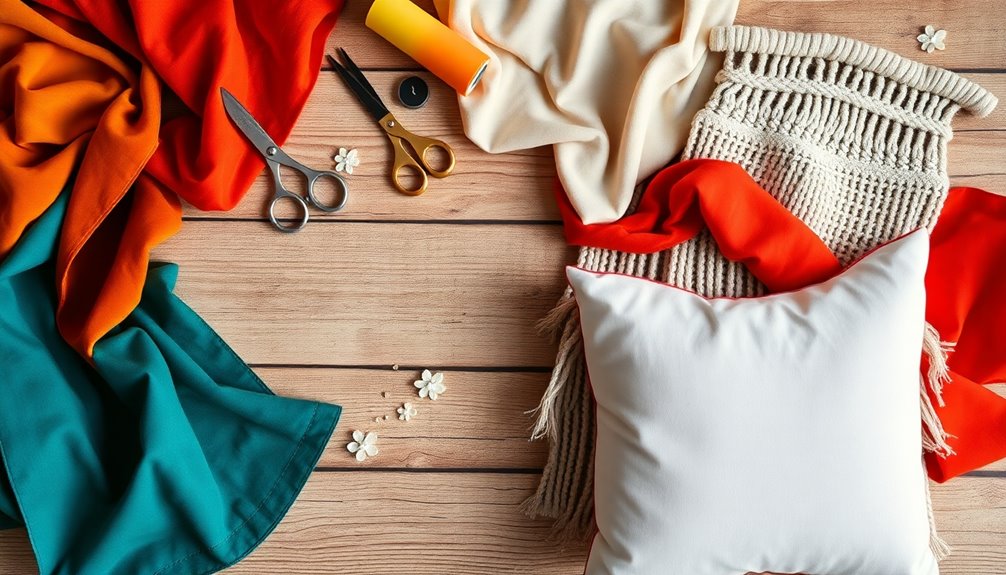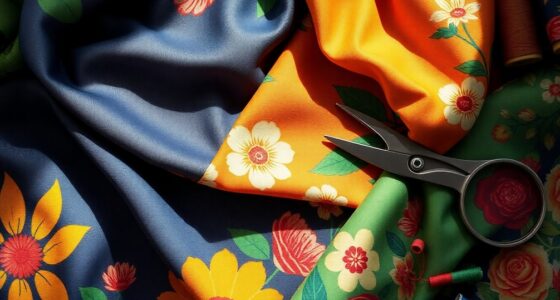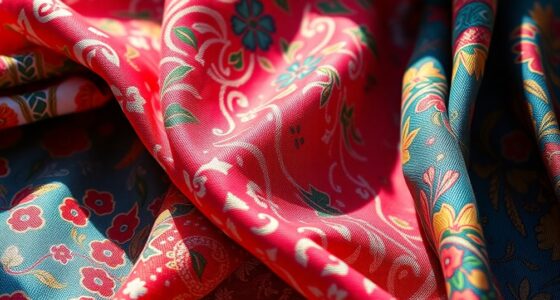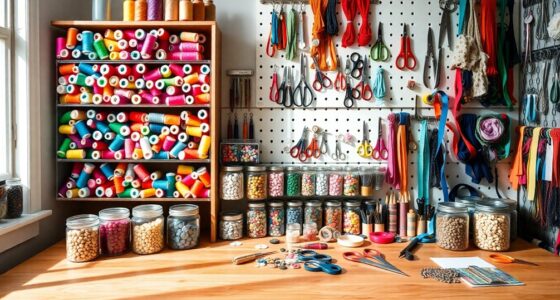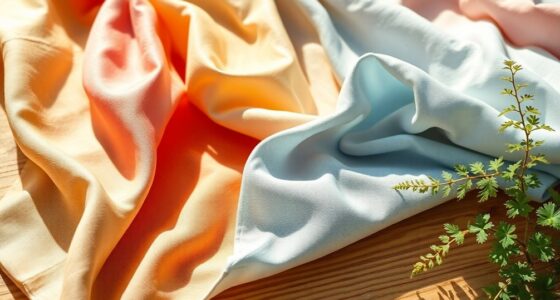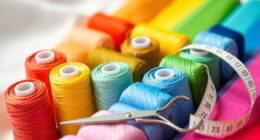For no-sew success, you need the right materials and techniques. Choose easy-to-handle fabrics like fleece and jersey, plus reliable adhesive products like fabric glue and fusible tape. Plan your design layout carefully to guarantee precision and incorporate decorative elements for visual appeal. Experiment with textures to add depth and always aim for a polished finish. Remember, patience and practice are key to mastering these methods, and there's more to explore that'll enhance your crafting skills!
Key Takeaways
- Choose fabrics like fleece and jersey for easy manipulation; they eliminate fraying and allow for flexible designs.
- Use fabric glue and fusible bonding tape to securely attach materials without sewing, ensuring a clean finish.
- Pre-wash all fabrics to prevent shrinkage and maintain the integrity of your projects over time.
- Incorporate embellishments like buttons and patches, using glue for creative flair while maintaining a professional appearance.
- Take your time to plan each step, regularly practicing techniques to improve skills and project quality.
Choosing the Right Materials for No-Sew Projects
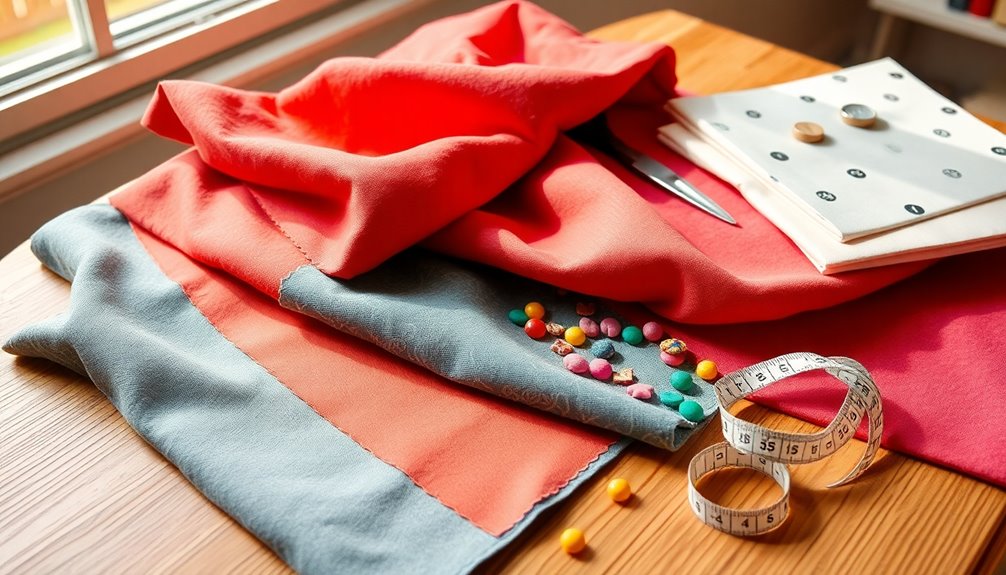
When you plunge into no-sew projects, choosing the right materials can make all the difference in your success.
Start with fabric types like fleece or jersey, which have a soft drape and are easy to manipulate. These materials can be tied without fraying, making them perfect for your creations.
Felt is also a fantastic choice; its sturdy structure provides a clean edge, eliminating the need for stitching.
Lightweight materials are essential too, as they facilitate easier folding and knotting.
Don't forget about adhesive products like fabric glue or fusible bonding tape, which secure your materials without sewing.
Finally, opt for pre-washed fabrics to minimize shrinkage and maintain the integrity of your no-sew masterpieces over time.
The Power of Fabric Glue and Adhesive Tapes
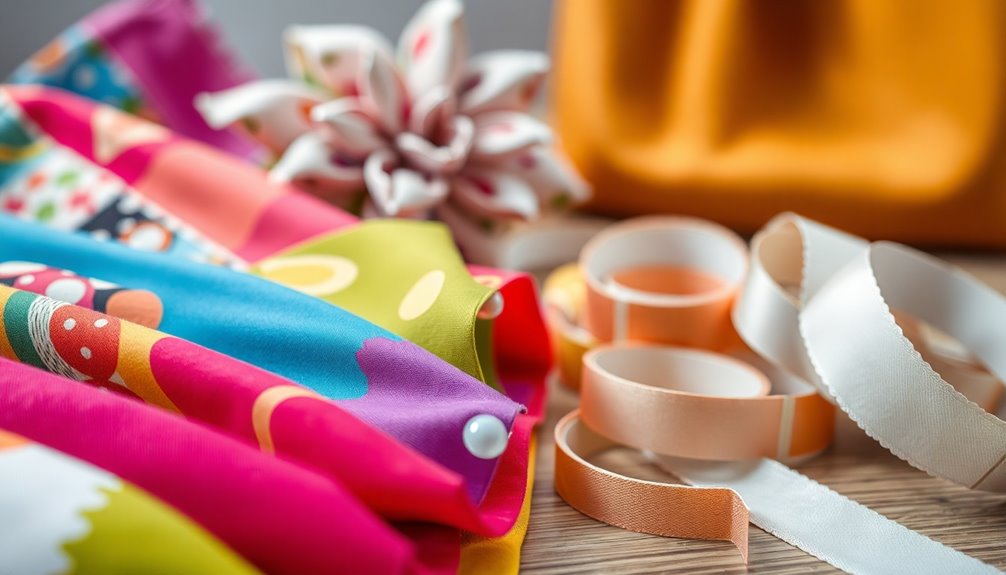
Fabric glue and adhesive tapes are game-changers for your no-sew projects.
You'll find a variety of options that cater to different materials, and using the right application techniques can guarantee a strong bond.
Plus, these methods save you time while giving you the flexibility to create or repair with ease.
Types of Fabric Adhesives
While you might think sewing is the only way to attach fabrics, the world of fabric adhesives offers quick and effective alternatives. Fabric glue is a versatile option that dries clear, making it perfect for securing edges, embellishments, and appliqués without any stitching. This is especially handy for those who may not have advanced sewing skills.
Additionally, fabric adhesive tapes like double-sided and fusible tape allow you to bond fabric layers easily, perfect for hems and repairs. When you choose fabric glue, make certain it's specifically designed for fabrics to guarantee flexibility after drying.
If you need temporary bonds, consider spray adhesives that let you reposition pieces before final adhesion. Following the manufacturer's instructions is key for successful use.
Application Techniques for Success
Utilizing the right application techniques can make all the difference in your no-sew projects. Fabric glue is a versatile adhesive that bonds various fabrics, providing a strong hold without stitching.
For a quick and mess-free experience, adhesive tapes like double-sided or fabric tape allow for precise placement of fabric pieces. Always follow the manufacturer's instructions regarding drying times and suitable fabrics to guarantee the best adhesion.
Before diving into your main project, test the adhesive on a small, inconspicuous area to check for any adverse reactions.
By incorporating these no-sew techniques, you can greatly reduce project time, making it perfect for beginners or anyone wanting effective fabric solutions quickly.
Happy crafting!
Benefits of No-Sew Methods
No-sew methods, like fabric glue and adhesive tapes, offer an efficient way to tackle projects without the stress of traditional sewing. You can quickly create something special with minimal effort, perfect for beginners or those short on time. Fabric glue provides a secure bond that's often machine washable, while adhesive tapes allow for strong seams without visible stitches. This enables you to experiment with new designs and customize items to reflect your unique style.
| Method | Benefits |
|---|---|
| Fabric Glue | Quick application, machine washable |
| Adhesive Tape | Strong seams, no visible stitches |
| Accessibility | No sewing skills needed, beginner-friendly |
Planning Your Design Layout for Precision
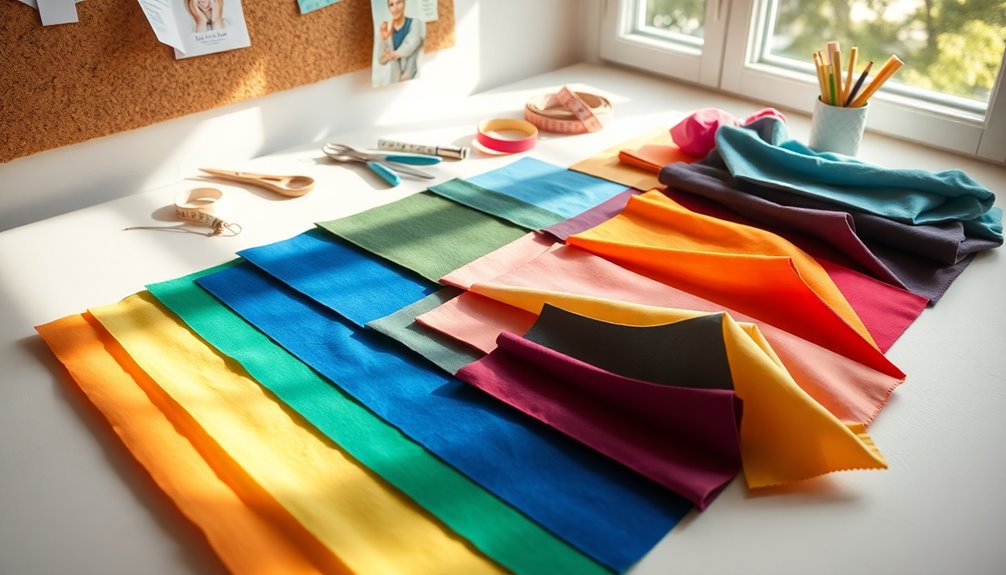
Planning your design layout is vital for achieving precision in your no-sew project. Start by sketching your design on paper; this helps you visualize the final product and identify necessary materials.
Use a ruler or measuring tape to guarantee accurate dimensions—mastering the art of measurement is essential for a professional finish. Consider fabric patterns and textures; aligning them properly can elevate your project's aesthetic.
Mark cut lines and folding points with fabric chalk or a fabric-safe pen to guide your no-sew techniques. Don't forget to plan for seam allowances and finishing edges to prevent fraying, making sure your project looks polished without sewing.
Careful layout planning sets the foundation for a stunning no-sew creation.
Incorporating Decorative Elements for Visual Appeal

When you choose decorative fabrics wisely, you set the stage for a standout no-sew project.
Applying embellishments effectively can transform a simple design into something truly eye-catching.
Let's explore how to elevate your creations with thoughtful choices and creative touches.
Choosing Decorative Fabrics Wisely
How do you choose the right decorative fabrics to elevate your no-sew projects? Start by considering the weight and drape of the fabric. Heavier materials provide structure, while lighter fabrics offer fluidity and movement.
Look for interesting textures like velvet, lace, or brocade to add depth and visual appeal. Pay attention to your color palette and patterns; harmonious combinations enhance your project's overall aesthetic.
Choose fabrics that are easy to manipulate, such as fusible fabric or felt, ensuring a seamless application. Additionally, consider incorporating eco-friendly materials that align with sustainable practices to make your projects even more appealing.
Finally, always pre-wash and press your decorative fabrics to remove any sizing or chemicals. This step helps them lay flat, giving your no-sew creations a polished finish that truly stands out.
Applying Embellishments Effectively
After selecting the right decorative fabrics, it's time to enhance your no-sew projects with embellishments that make them truly stand out.
Use fabric glue or adhesive transfer sheets to securely attach items like sequins, beads, or fabric patches. This guarantees a clean, professional finish without sewing.
Consider iron-on embellishments for quick application; just apply heat to activate the adhesive. Layering different elements, such as ribbons and trims, adds depth and texture while keeping a cohesive look.
Always test your chosen adhesives on a fabric scrap first to verify compatibility and prevent damage to your main project fabric.
With these tips, you'll effortlessly elevate your creations and showcase your personal style!
Experimenting With Textures for Added Depth
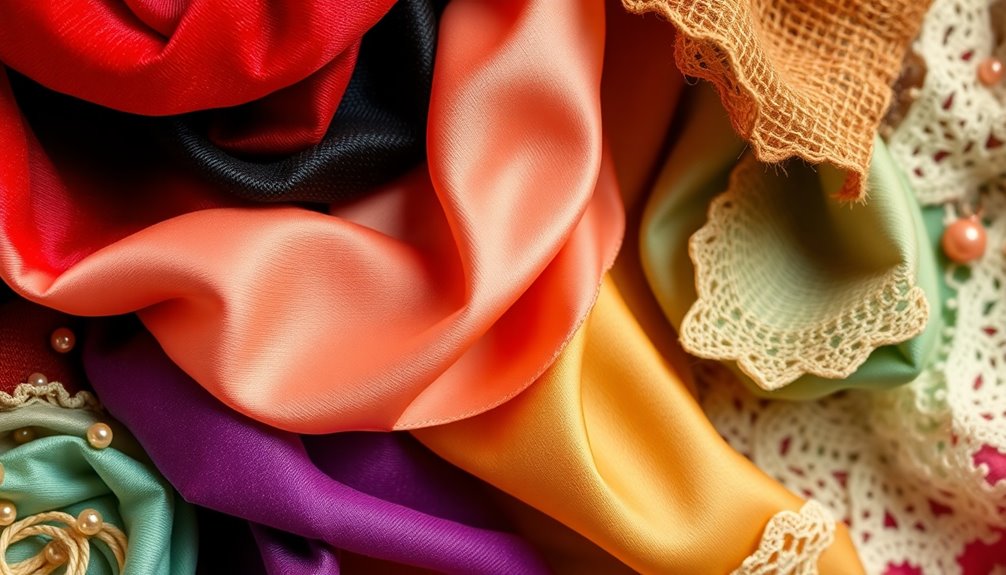
Experimenting with textures not only enhances the visual appeal of your no-sew projects but also invites a deeper sensory experience.
By mixing materials, you can create engaging designs that draw attention. Reflect on these tips:
- Combine smooth fabrics like satin with rougher materials such as burlap for contrast.
- Pair thick denim with delicate chiffon to add complexity.
- Use embellishments like lace, sequins, or ribbons to introduce additional dimension.
- Layer different textures to evoke a tactile experience that encourages interaction.
As you explore these options, remember to take into account the weight and drape of each material to guarantee they work together harmoniously, maintaining a cohesive look throughout your project. Incorporating unique pieces can not only elevate your designs but also provide a charming touch that reflects individual tastes.
Embrace creativity and enjoy the process!
Techniques for Achieving a Polished Finish
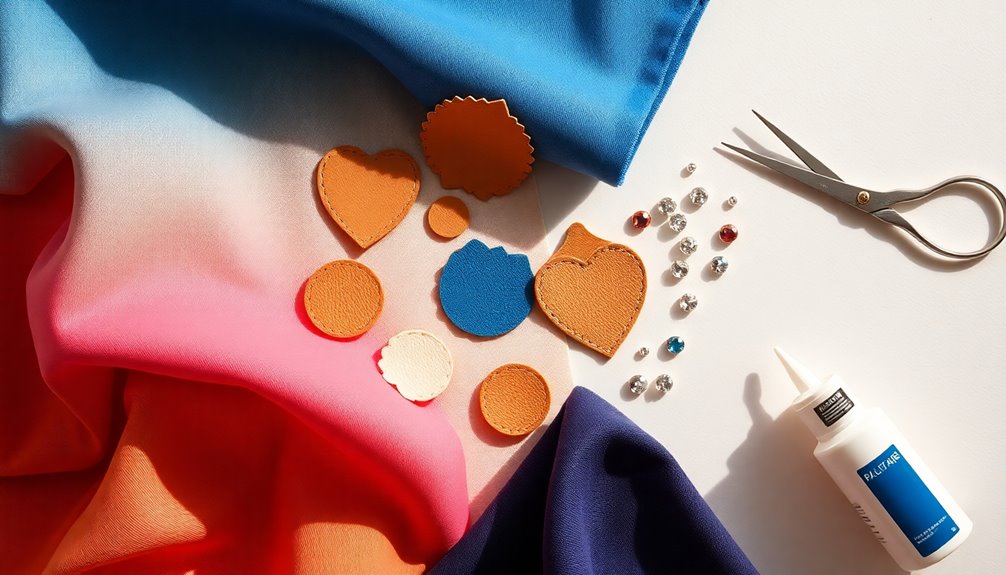
Achieving a polished finish in your no-sew projects is essential for creating a professional look. Start by using fabric glue or fusible tape to bond edges and seams securely, guaranteeing no visible stitches.
Incorporate bias tape along raw edges; it not only enhances durability but also provides a finished appearance, preventing fraying. For a refined touch, heat-activated adhesive sheets allow for precise bonding of fabric layers, which you can easily trim for a seamless finish.
Adding embellishments like iron-on patches or decorative trims elevates your project's aesthetic, giving it a unique flair.
Finally, guarantee neat corners and curves by using a hot knife or rotary cutter, and fold or tuck edges for crisp lines that scream professionalism.
Tips for Maintaining Flexibility in No-Sew Projects
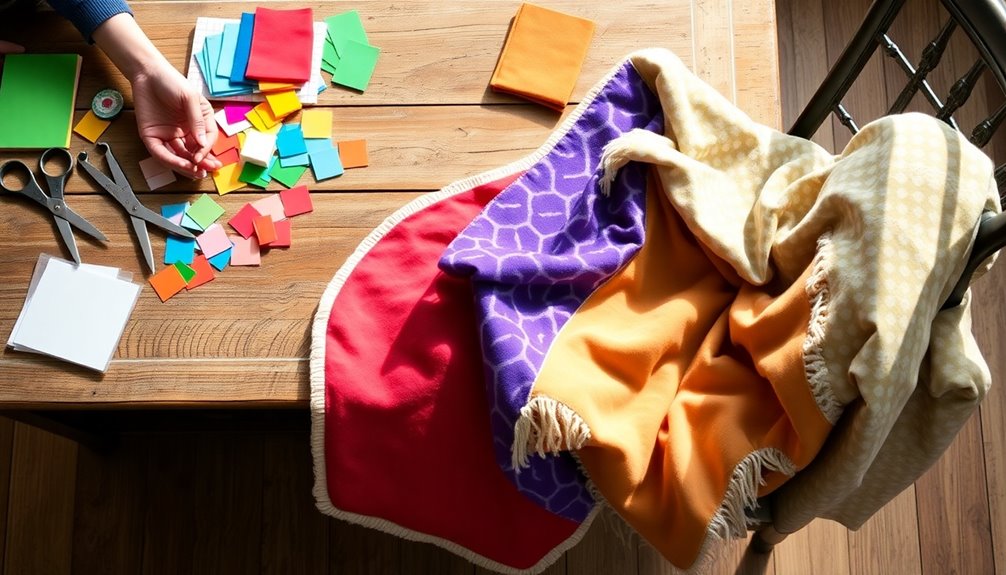
To keep your no-sew projects flexible and functional, focus on choosing the right materials and adhesives. Here are some tips to help you maintain that flexibility:
- Embrace fabric glue for a flexible bond, allowing easy adjustments during crafting.
- Utilize fusible bonding tape to join fabric edges seamlessly, keeping the fabric's natural drape.
- Incorporate embellishments like buttons and patches attached with glue for creative flair without sacrificing flexibility.
- Choose lightweight, stretchable fabrics like jersey or fleece to guarantee comfort and adaptability in your finished item.
Regularly testing adhesive effectiveness on fabric scraps can also help you maintain the desired flexibility and durability in your no-sew projects, guaranteeing they remain versatile and practical for everyday use.
Patience and Practice: Keys to Your Success
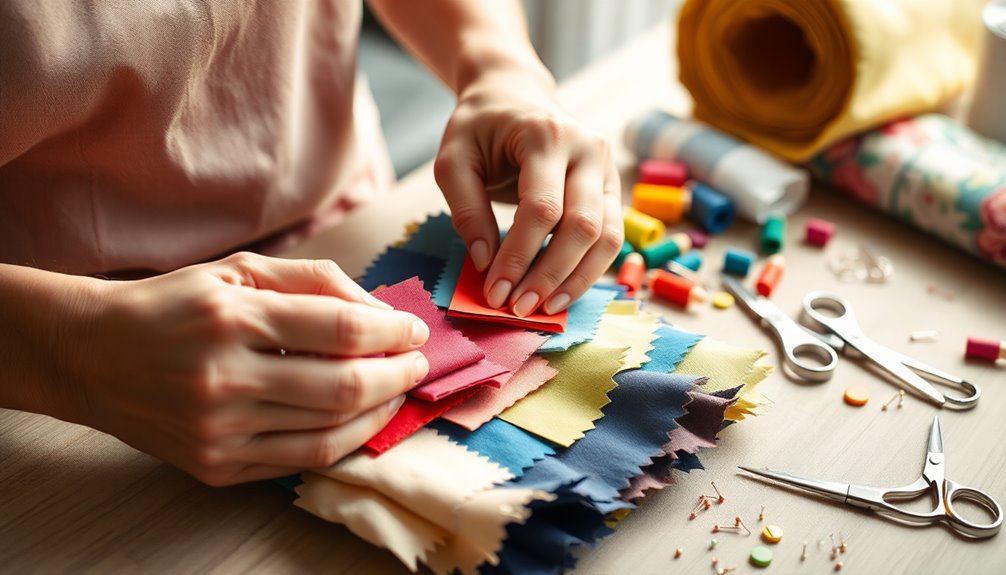
While diving into no-sew projects, patience and practice are essential for achieving the best results.
Take your time to plan each step carefully; this attention to detail can greatly enhance your project's quality. Regular practice will help you develop your skills, allowing you to master various techniques and gain confidence in your abilities.
Don't hesitate to experiment with different fabrics and approaches during your practice sessions; you might discover personal preferences that reveal new creative possibilities.
Setting realistic goals for each project keeps you motivated and makes the learning process enjoyable.
Finally, maintain a journal to track your projects and techniques, helping you reflect on your progress and identify areas for further growth.
Embrace the journey!
Frequently Asked Questions
Can I Use Regular Glue Instead of Fabric Glue?
You can use regular glue instead of fabric glue, but it mightn't give you the best results.
Regular glue can dry stiff and may not hold up well under stress or washing.
Fabric glue is specifically designed to remain flexible and durable, making it ideal for fabric projects.
If you're in a pinch, use regular glue, but for long-lasting results, it's best to stick with fabric glue whenever possible.
How Do I Fix Mistakes in No-Sew Projects?
When you find yourself in a bit of a pickle with no-sew projects, don't worry! Mistakes happen to the best of us.
First, assess what went wrong—maybe a seam's off or glue's showing. If it's a misalignment, carefully peel back the fabric and reposition it.
For excess glue, use a damp cloth to wipe it away. Just remember, a little patience goes a long way in fixing those hiccups!
What Types of Fabrics Work Best for No-Sew Techniques?
When you're diving into no-sew projects, choose fabrics that are easy to manipulate and hold their shape.
Lightweight cottons and fleece work great, as they don't fray easily and are simple to cut.
You'll also find that felt is a fantastic option since it doesn't unravel.
Stay away from slippery fabrics like silk, as they can be tricky to handle.
Always consider the project's purpose and the fabric's durability!
Can No-Sew Projects Be Washed or Cleaned?
When it comes to no-sew projects, you can't judge a book by its cover.
Yes, many no-sew items can be washed, but it depends on the materials you've used. Check care labels, as some fabrics might shrink or fray. For best results, hand wash gently and air dry.
If you've used adhesives, be cautious, as some may not hold up well in water. Always test a small area first to avoid surprises!
How Do I Attach Heavy Embellishments Without Sewing?
To attach heavy embellishments without sewing, you can use strong fabric glue or a hot glue gun.
Start by cleaning the surface where you'll apply the embellishments. Apply a generous amount of glue, press the embellishment firmly, and hold it in place until it sets.
For extra security, consider using adhesive patches or fabric tape. Always check the manufacturer's instructions for the best results, ensuring your embellishments stay put through wear and cleaning.
Conclusion
Incorporating no-sew techniques can open up a world of creativity for you. Did you know that 60% of crafters prefer no-sew methods for their ease and versatility? By choosing the right materials, utilizing fabric glue, and adding decorative elements, you can create stunning projects that look professionally done. Remember, patience and practice are your best friends in mastering these skills. So grab your supplies, release your creativity, and enjoy the seamless journey ahead!
